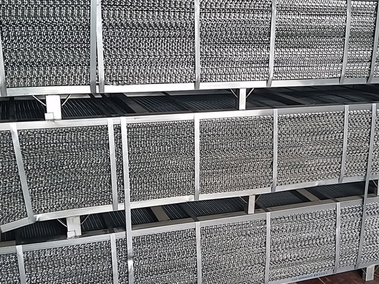

Plaster mesh helps to form the internal skeleton layers of plaster and putty. In differences of temperature and humidity, under mechanical stress, plaster mesh will provide excellent protection for the plastering layer area. Plaster mesh makes it has a high resistance to wear and is able to withstand heavy loads.
Plaster mesh is normally used for internal and external plastering, it is also actively used in the production of self-leveling floors, installation of thermal insulation and acoustic insulation materials, waterproofing, separation of heterogeneous layers, and the junction of the walls doorframes. Plastering mesh is used to protect the facades of buildings and structures. Plastic and fiberglass mesh is also perfectly used for places where the window and door frames are connected to the wall, and the wall adjacent to the floor or ceiling.
Plaster Metal Lath
There are many types of plaster mesh: Galvanized chicken wire, welded wire mesh, light type expanded metal, chain wire mesh, fine woven wire mesh, fiberglass cloth, and plastic netting.
Various types of plastering mesh have different mechanical and physical properties. Based on this, and it is worth buying a particular type of mesh - suitable for a particular work.
We will tell you how to choose a suitable plastering mesh, list as below.
Reinforcing plaster mesh is perfectly suited for the reinforcement and restoration of existing plaster and brickwork.
The fiberglass cloth mesh is made of glass fiber and then impregnated with an alkaline dispersion - increased resistance to tearing. It has high reliability, durability, and longevity. It is very effective when using quick-dry finishing mixtures.

Plaster Metal Lath
A very important indicator of this mesh is its surface density. For example, a front wall mesh varies in the range from 165 to 300g/sq.m. Maximally dense mesh is used on the lower floors, as in this case a very high risk of both natural and intentional damage to the front elevation. A plaster mesh with a density in the range of 110 to 160g/sq.m. is fine for internal construction and finishing work. Masking fiberglass mesh for reinforcing walls before painting the walls or for putty works, its mesh opening needs extremely small.
The mesh performance depends not only on the material and size but the mesh opening shape.
Light type expanded metal with a diamond hole shape is almost indispensable for plastering work. Its diamond shape holes allow maximum grip to the plaster layer. Due to its excellent characteristics, it is frequently used for the installation of underfloor heating.
Welded wire mesh manufactured by welding rods perpendicular to the wire is also used in the manufacture of plaster works, but somewhat less than expanded metal. It is often used in the production of fences and cages in poultry and livestock.
Metal plaster mesh has a different coefficient of linear thermal expansion with a plaster layer. With twist woven structure and hexagonal shape mesh, chicken wire is sufficiently acceptable for plastering better than rigid mesh - welded wire mesh and expanded metal. Due to its flexibility unimaginable property, the chicken mesh is quite convenient to attach to various angular and curved surfaces.
If you want to get more information about the plaster metal lath, welcome to contact us today or request a quote.
